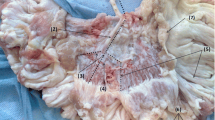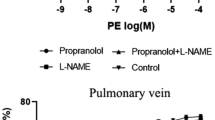Summary
This study in the anaesthetized rabbit aimed at determining the role of nitric oxide (NO), the putative endothelium-derived relaxing factor, in the regulation of haemodynamics and the release into plasma of noradrenaline and adrenaline. Specific inhibition of NO formation was achieved by i.v. bolus injection of l-NG-monomethyl-arginine (l-NMMA; 3–100 mg kg−1). Phenylephrine was infused i.v. at constant rates (2.5–20 μg kg−1 min−1) in order to assess baroreflex-mediated changes in release due to direct peripheral vasoconstriction. Rates of noradrenaline and adrenaline release into plasma were determined by the radio-tracer technique. l-NMMA, but not d-NMMA, dose-dependently increased mean arterial pressure and total peripheral vasular resistance, whereas both heart rate and cardiac output decreased concomitantly. The corresponding ED50 values for l-NMMA ranged from 11.2 to 18.5 mg kg−1. Inhibition of NO formation by l-NMMA as well as phenylephrine infusion caused decreases in the plasma clearance of noradrenaline and adrenaline which were correlated with the drug-induced decreases in cardiac output. Both l-NMMA and phenylephrine reduced the rate of noradrenaline release into plasma as they increased total peripheral resistance. Moreover, the curvilinear relationship between these two parameters obtained for l-NMMA was virtually identical to that produced by phenylephrine, indicating that the reduction in noradrenaline release by l-NMMA is mediated solely by the baroreflex. From the l-NMMA-induced maximum inhibition of noradrenaline release, it is concluded that the counter-regulation against peripheral vasodilation by NO accounts for 69% of basal noradrenaline release. The baroreflex-sensitive component of noradrenaline release, as determined by the maximum inhibition of release induced by phenylephrine, amounted to 83% of basal release. l-NMMA also reduced the release into plasma of adrenaline; the maximum inhibition of release was 52%. However, when related to total peripheral resistance, this inhibition of adrenaline release was more pronounced than that induced by phenylephrine, suggesting that the formation of endogenous NO facilitates the release of adrenaline.
Similar content being viewed by others
References
Aisaka K, Gross SS, Griffith OW, Levi R (1989) NG-Methyl-arginine, an inhibitor of endothelium-derived nitric oxide synthesis, is a potent pressor agent in the guinea pig: does nitric oxide regulate blood pressure in vivo? Biochem Biophys Res Commun 160:881–886
Bassenge E, Heusch G (1990) Endothelial and neuro-humoral control of coronary blood flow in health and disease. Rev Physiol Biochem Pharmacol 116:77–165
Bredt DS, Hwang PM, Snyder SH (1990) Localization of nitric oxide synthase indicating a neural role for nitric oxide. Nature 347:768–770
Cohen RA, Weisbrod RM (1988) Endothelium inhibits nor-epinephrine release from adrenergic nerves of rabbit carotid artery. Am J Physiol 254: H871-H878
Corbin JL, Reporter M (1974) NG-Methylated arginines; a convenient preparation of NG-methylarginine. Anal Biochem 57:310–312
Dohi T, Morita K, Tsujimoto A (1983) Effect of sodium azide on catecholamine release from isolated adrenal gland and on guanylate cyclase. Eur J Pharmacol 94:331–335
Esler M, Jackman G, Bobik A, Kelleher D, Jennings G, Leonard P, Skews H, Korner P (1979) Determination of norepinephrine apparent release rate and clearance in humans. Life Sci 25:1461–1470
Esler M, Jennings G, Kerner P, Willett I, Dudley F, Hasking G, Anderson W, Lambert G (1988) Assessment of human sympathetic nervous system activity from measurements of norepinephrine turnover. Hypertension 11:3–20
Fozard JR, Part M-L (1991) Haemodynamic responses to NG-monomethyl-l-arginine in spontaneously hypertensive and normotensive Wistar-Kyoto rats. Br J Pharmacol 102: 823–826
Furchgott RF, Zawadzki JV (1980) The obligatory role of endothelial cells in the relaxation of arterial smooth muscle by acetylcholine. Nature 288:373–376
Gardiner SM, Compton AM, Bennett T, Palmer RMJ, Moncada S (1990a) Control of regional blood flow by endothelium-derived nitric oxide. Hypertension 15:486–492
Gardiner SM, Compton AM, Kemp PA, Bennett T (1990b) Regional and cardiac haemodynamic effects of NG-nitre-l-arginine methyl ester in conscious, Long Evans rats. Br J Pharmacol 101:625–631
Gardiner SM, Compton AM, Kemp PA, Bennett T(1991) Effects of NG-nitre-l-arginine methyl ester or indomethacin on differential regional and cardiac haemodynamic actions of arginine vasopressin and lysine vasopressin in conscious rats. Br J Pharmacol 102:65–72
Greenberg SS, Diecke FPJ, Cantor E, Peevy K, Tanaka TP (1990) Inhibition of sympathetic neurotransmitter release by modulators of cyclic GMP in canine vascular smooth muscle. Eur J Pharmacol 187:409–423
Gustafsson LE, Wiklund NP, Wiklund CU, Cederqvist B, Persson MG, Moncada S (1990) Modulation of autonomic neuroeffector transmission by nitric oxide-like activity in guinea-pig smooth muscle. In: Moncada S, Higgs EA (eds) Nitric oxide from l-arginine: a bioregulatory system. Elsevier, Amsterdam New York Oxford, pp 177–181
Halbrügge T, Gerhardt T, Ludwig J, Heidbreder E, Graefe K-H (1988) Assay of catecholamines and dihydroxyphenyl-ethyleneglycol in human plasma and its application in orthostasis and mental stress. Life Sci 43:19–26
Halbrügge T, Liltsch K (1991) Effects of inhibition of EDRF formation on haemodynamics and noradrenaline release. Naunyn-Schmiedeberg's Arch Pharmacol 343 [Suppl]:R95
Hasking GJ, Ester MD, Jennings GL, Burton D, Johns JA, Korner PI (1986) Norepinephrine spillover to plasma in patients with congestive heart failure: evidence of increased overall and cardiorenal sympathetic nervous activity. Circulation 73:615–621
Hof RP, Hof A, Takiguchi Y (1990) Attenuation of endothelin-induced regional vasoconstriction by isradipine: a nonspecific antivasoconstrictor effect. J Cardiovasc Pharmacol 15 [Suppl]: S48-S54
Ignarro LJ, Buga GM, Wood KS, Byrns RE, Chaudhuri G (1987) Endothelium-derived relaxing factor produced and released from artery and vein is nitric oxide. Proc Natl Acad Sci USA 84:9265–9269
Ludwig J, Halbrügge T, Vey G, Walter J, Graefe K-H (1989) Haemodynamics as a determinant of the pharmacokinetics of and the plasma catecholamine responses to isoprenaline. Eur J Clin Pharmacol 37:493–500
O'Sullivan AJ, Burgoyne RD (1990) Cyclic GMP regulates nicotine-induced secretion from cultured bovine adrenal chromaffin cells: effects of 8-bromo-cyclic GMP, atrial natriuretic peptide, and nitroprusside (nitric oxide). J Neurochem 54:1805–1808
Palacios M, Knowles RG, Palmer RMJ, Moncada S (1989) Nitric oxide from l-arginine stimulates the soluble guanylate cyclase in adrenal glands. Biochem Biophys Res Commun 165:802–809
Palmer RMJ, Ferrige AG, Moncada S (1987) Nitric oxide release accounts for the biological activity of endothelium-derived relaxing factor. Nature 327:524–526
Palmer RMJ, Ashton DS, Moncada S (1988) Vascular endothelial cells synthesize nitric oxide from l-arginine. Nature 333:664–666
Rees DD, Palmer RMJ, Moncada S (1989) Role of endothelium-derived nitric oxide in the regulation of blood pressure. Proc Natl Acad Sci USA 86:3375–3378
Rees DD, Palmer RMJ, Schulz R, Hodson HF, Moncada S (1990) Characterization of three inhibitors of endothelial nitric oxide synthase in vitro and in vivo. Br J Pharmacol 101:746–752
Sakuma I, Stuehr DJ, Gross SS, Nathan C, Levi R (1988) Identification of arginine as a precursor of endothelium-derived relaxing factor. Proc Natl Acad Sci USA 85:8664–8667
Sakuma I, Togashi H, Yoshioka M, Kobayashi T, Saito H, Yasuda H, Gross SS, Levi R (1990) Effects of intravenous and intracisternal administration of NG,-monomethyl-l-arginine on renal sympathetic nerve activity in anaesthetized rats. In: Moncada S, Higgs EA (eds) Nitric oxide from l-arginine: a bioregulatory system. Elsevier, Amsterdam New York Oxford, pp 493–494
Snyder SH, Bredt DS (1991) Nitric oxide as a neuronal messenger. Trends Pharmacol Sci 12:125–128
Sullebarger JT, Liang C-S, Woolf PD, Willick AE, Richeson JF (1990) Comparison of phenylephrine bolus and infusion methods in baroreflex measurements. J Appl Physiol 69:962–967
Szabo B, Hedler L, Starke K (1989) Peripheral presynaptic and central effects of clonidine, yohimbine and rauwolscine on the sympathetic nervous system in rabbits. Naunyn-Schmiedeberg's Arch Pharmacol 340:648–657
Tesfamariam B, Weisbrod RM, Cohen RA (1987) Endothelium inhibits responses of rabbit carotid artery to adrenergic nerve stimulation. Am J Physiol 253: H792-H798
Vargas HM, Ignarro LJ, Chaudhuri G (1990) Physiological release of nitric oxide is dependent on the level of vascular tone. Eur J Pharmacol 190: 393–397
Walder CE, Thiemermann C, Vane JR (1991) The involvement of endothelium-derived relaxing factor in the regulation of renal cortical blood flow in the rat. Br J Pharmacol 102:967–973
Waldman SA, Murad F (1987) Cyclic GMP synthesis and function. Pharmacol Rev 39:163–196
Winne D (1965) Zur Auswertung von Versuchsergebnissen: Die Prüfung, ob Kurven sich in ihrem Verlauf unterscheiden. Naunyn-Schmiedeberg's Arch Exp Pathol Pharmakol 250:383–396
Author information
Authors and Affiliations
Additional information
This study was supported by the Deutsche Forschungsgemeinschaft (Gr 490/5-3). A preliminary account of the present results was presented to the German Pharmacological Society (Halbrügge and Lütsch 1991)
Send offprint requests to T. Halbrügge at the above address
Rights and permissions
About this article
Cite this article
Halbrugge, T., Lutsch, K., Thyen, A. et al. Role of nitric oxide formation in the regulation of haemodynamics and the release of noradrenaline and adrenaline. Naunyn-Schmiedeberg's Arch Pharmacol 344, 720–727 (1991). https://doi.org/10.1007/BF00174757
Received:
Accepted:
Issue Date:
DOI: https://doi.org/10.1007/BF00174757




